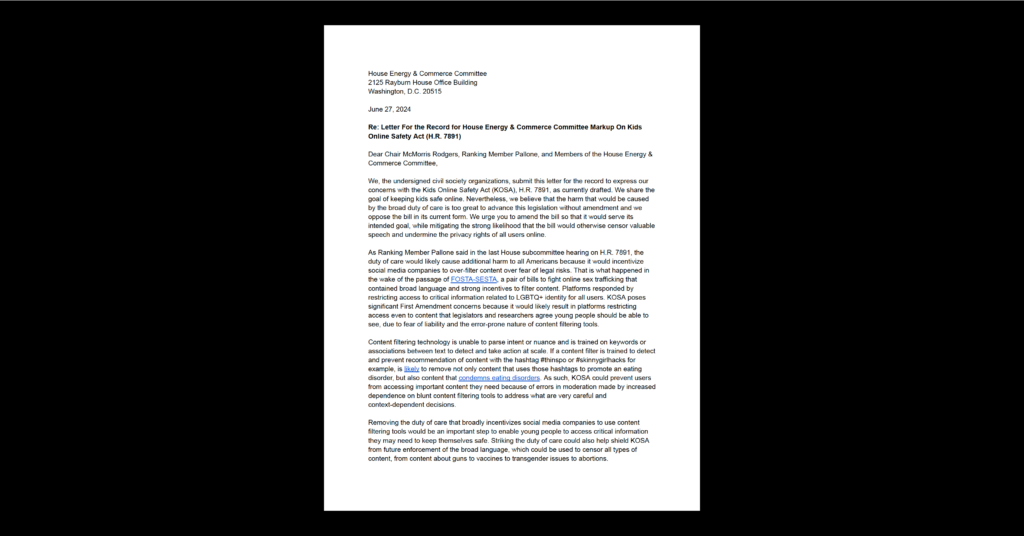AI Policy & Governance, Equity in Civic Technology, Government Surveillance, Privacy & Data
Student Privacy a Concern During Implementation of the Bipartisan Safer Communities Act
By Kristen Abram
In June, President Joe Biden signed the Bipartisan Safer Communities Act into law. While the legislation’s aim to promote student and school safety is commendable, it could have unintended consequences that undermine student privacy and disproportionately harm marginalized groups of students.
In particular, without adequate safeguards, four of the law’s programs could increase the collection — and potential misuse — of data on marginalized students and increase the proliferation of untested surveillance technology in schools. Policymakers should address those concerns as they implement the legislation to ensure that efforts to bolster student safety do not come at the expense of student privacy or inadvertently harm students.
Increased Data Collection and Risk of Misuse
Mental Health Screening
The law provides $50 million for grants to states to support access to school-based health care services under Medicaid and the Children’s Health Insurance Program (CHIP)CHIP. Medicaid largely benefits, and has restricted eligibility criteria that includes, populations of traditionally marginalized students such as students with disabilities, students of color, and students from low-income families. Schools can provide critical health services under these programs at school-based health centers, including services like Early and Periodic Screening, Diagnostic, and Treatment (EPSDT), which requires states to provide Medicaid-eligible children appropriate preventative care and necessary medical services like mental health screenings.
These screenings are required for children enrolled in Medicaid, and as schools administer the screenings, they will have access to information from the screenings, including information on students’ mental health. Without adequate safeguards, the information collected from these screenings could potentially be used by school officials to not only refer students for necessary mental health resources but also in ways not anticipated by students or their families, such as profiling for threat assessments.
In turn, this could lead to increased disciplinary actions or even contact with law enforcement for the marginalized groups of students who are eligible for Medicaid. Policymakers should mitigate this concern by ensuring this information is only used to support students and that mental health screening is conducted equitably.
Increased Access to Juvenile Justice Records
The law also expands existing federal and state background checks on prospective gun buyers, called the National Instant Criminal Background Check System (NICS), to include more extensive background checks for gun purchasers under 21. Under current law, a licensed firearms dealer must ask state or federal officials to query the NICS databases for state and federal records that may disqualify an individual from purchasing a firearm.
The Bipartisan Safer Communities Act expands this requirement so that NICS must immediately contact the appropriate state “juvenile justice information system” and state “custodian of mental health adjudication records” to search for possibly disqualifying juvenile records. It also provides $200 million for states to upgrade criminal and mental health records for the NICS, which are well-established to be lacking and incomplete.
The agencies implementing the Safer Communities Act should account for the increased privacy risks posed by the expansion of NICS to include juvenile records. Records regarding a juvenile’s mental health and law enforcement interactions are particularly sensitive. The expansion allows new stakeholders to access these juvenile records, increasing the risk of their misuse or disclosure and resulting stigmatization or adverse impacts.
Thus, policymakers and their state partners should ensure that the use of juvenile records is accompanied by adequate safeguards, such as:
- Limitations on the records’ use, restricting it to only their intended purpose of checking for disqualifying criminal or mental health history;
- Restrictions on the records’ retention, as unnecessarily maintaining the records across multiple stakeholders elevates the risk of misuse or disclosure in a data breach;
- Physical, technical, and administrative access controls to ensure that only authorized personnel may access the records;
- Robust cybersecurity protections for the records, both at rest and during transmission, to help reduce the risk of a data breach; and,
- Adequate procedures to provide individuals with notice of the use of their juvenile records, an appeals or grievance process, and a process for correcting the underlying records if they are erroneous.
Proliferation of Untested Surveillance Technology
Increased Funding for School Security
The law provides $200 million for the Office of Community Oriented Policing Services (COPS Office) within the Department of Justice (DOJ), which was established by the STOP School Violence Act of 2018. Currently, STOP Program funding can be used for data- and technology-driven interventions like anonymous reporting systems for threats of school violence, or threat assessment and intervention teams in coordination with law enforcement. Furthermore, federal guidance states that, “Schools should use technology to improve school security . . . [like] cameras, communication technology, access control, and identification technology.” Notably, the same guidance also acknowledges that school safety technology is an area that needs further research, and recent reporting has suggested that the technology has not lived up to its safety promises, despite coming at the expense of student privacy.
Given the urgency to act and influx of funding, schools may procure school safety technologies that not only lack reliable research demonstrating their efficacy, but are also proven to cause student harm. For example, a variety of school safety technologies, including all-in-one security platforms and visitor management systems, potentially jeopardize student privacy and disproportionately impact students from historically marginalized communities. Those technologies often lack transparent data practices. This dissonance between purported benefits and actual practice raises the concern that funding from the bill will go towards continued use and development of technologies that perpetuate inequitable outcomes.
School Safety Clearinghouse
The law amends the Homeland Security Act of 2002 to establish the Federal Clearinghouse on School Safety Evidence-based Practices, within the Department of Homeland Security (DHS). The Clearinghouse aims to serve as a federal resource to identify evidence-based practices to improve school safety, which will be determined in consultation with the Department of Education (ED) and “Federal, State, local, Tribal, private sector, and nongovernmental organizations.”
The legislation requires the Clearinghouse to consult with various organizations, which could include private sector organizations with a financial interest in marketing school surveillance technology to purportedly protect student safety. That creates the possibility that the Clearinghouse will be unduly influenced in its recommendations and not adequately protect student privacy. Independent research regarding the efficacy of surveillance technology in protecting students is inadequate and inconclusive — creating an opening for vendors and others with a financial interest to fund purported research and otherwise influence the contents of the Clearinghouse.
As a result, instead of protecting students, the ultimate result of the Clearinghouse could be the proliferation of untested surveillance technology in schools, which must often make decisions about use and implementation of technology without being properly informed. In implementing the Clearinghouse, DHS should ensure that it is consulting with independent experts in student privacy and in the discriminatory impacts of certain school safety technologies to ensure that the Clearinghouse’s recommendations help — not harm — students.
Conclusion
Ultimately, while the Bipartisan Safer Communities Act has the potential to improve student safety in the classroom, it also raises concerns regarding privacy and the disproportionate impact on marginalized groups of students. With this in mind, it is important that federal policymakers within DHS, DOJ, HHS and ED actively work to mitigate these potential harms in the implementation of the bill.


